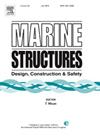Mitigating load responses of high-speed catamarans via ride control systems: An experimental study in irregular waves, part1: Slam events
IF 5.1
2区 工程技术
Q1 ENGINEERING, CIVIL
引用次数: 0
Abstract
This study aims to investigate the influence of a Ride Control System (RCS) on the load responses of a 2.5 m hydroelastic segmented catamaran model, which represents a 112 m high-speed catamaran. The efficacy of different control algorithms in mitigating slam rates and magnitudes was quantified by comparing results with those obtained for a bare hull with the No RCS control mode. Towing tank experiments were conducted in irregular head seas with a forward speed of 2.89 m/s (37 knots full-scale) at two significant wave heights. The results revealed that the nonlinear pitch control algorithm was the most efficient, achieving an impressive 96% reduction in slam occurrence, a 70% reduction in maximum slam magnitude, and a 66% reduction in maximum slam-induced sagging bending moments in moderate waves. Additionally, it was revealed that increases in wave height elevated the probability of slams, amplified variance in the distribution of slam loads and slam-induced bending moments and reduced the influence of the RCS in mitigating structural loads on the catamaran model. It was shown that irregular sea slam responses can be predicted from regular sea data, based on regular tests at a frequency corresponding to the modal period of the irregular sea case, with an accuracy of within 8 % for moderate waves and within 15 % at large waves.
通过平顺控制系统减轻高速双体船的负载响应:不规则波浪中的实验研究,第1部分:Slam事件
本研究旨在探讨平顺性控制系统(RCS)对代表112米高速双体船的2.5米水弹性分段双体船模型载荷响应的影响。通过与无RCS控制模式下裸船体的结果比较,量化了不同控制算法在减轻撞击率和震级方面的效果。拖曳箱实验在不规则的头海进行,在两个不同的浪高下,前进速度为2.89米/秒(37节)。结果表明,非线性俯仰控制算法是最有效的,在中等波浪中,slam发生率降低96%,最大slam强度降低70%,最大slam引起的下垂弯矩降低66%。此外,波浪高度的增加增加了碰撞的概率,放大了碰撞荷载和碰撞弯矩分布的方差,降低了RCS对双体船模型结构荷载的缓解作用。结果表明,基于与不规则海况模态周期相对应的频率的常规试验,可以从常规海况数据中预测不规则海况撞击响应,中等海浪的精度在8%以内,大浪的精度在15%以内。
本文章由计算机程序翻译,如有差异,请以英文原文为准。
求助全文
约1分钟内获得全文
求助全文
来源期刊

Marine Structures
工程技术-工程:海洋
CiteScore
8.70
自引率
7.70%
发文量
157
审稿时长
6.4 months
期刊介绍:
This journal aims to provide a medium for presentation and discussion of the latest developments in research, design, fabrication and in-service experience relating to marine structures, i.e., all structures of steel, concrete, light alloy or composite construction having an interface with the sea, including ships, fixed and mobile offshore platforms, submarine and submersibles, pipelines, subsea systems for shallow and deep ocean operations and coastal structures such as piers.
 求助内容:
求助内容: 应助结果提醒方式:
应助结果提醒方式:


